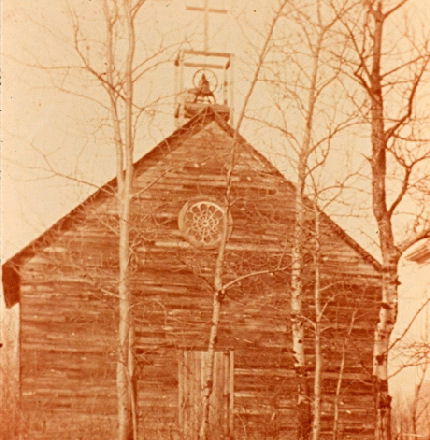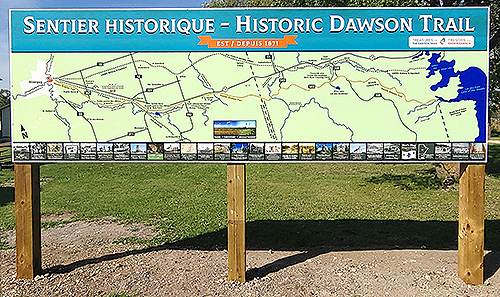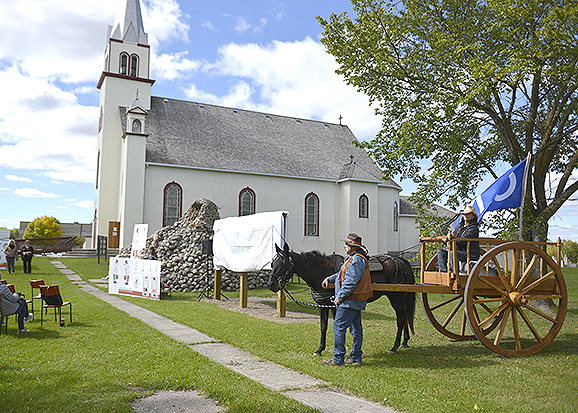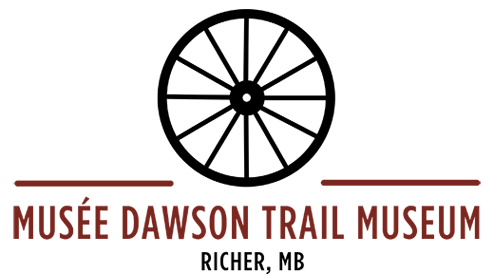A Site History
April 12, 2022 by admin7
The site of the Dawson Trial Museum tells an over 100 year old story.

We invite you to read a time line of the site's history from its early beginnings in 1901 to the present.
A Site History
1901 - Celebration of the first mass in the village of Thibaultville, on April 1 by Fr. R. Giroux in l’École Rouge (The Red Schoolhouse). The village, Côteau des Chênes, takes on the name of Thibaultville in honour of Fr. Jean-Baptiste Thibault, a secular priest working at the service of the Saint-Boniface Archdiocese.
1902 - Fr. Alexandre Defoy arrives in Ste-Anne and is designated as vicar; he is assigned to provide services to the Thibaultville Mission on February 17, 1903.
1903 - A lot is given by Mr. Pierre and Mrs. Hélène (Fabvreau) Michaud for the construction of a chapel. This is the land where at present stands the Enfant-Jésus Church, the St. Joseph House and the two garages. Parts of the lot have been sold for the construction of the present Richer School.
1904 - Blessing of the first chapel by Fr. A. Defoy who has been named first priest of the new parish of the Enfant-Jésus by Mgr Adélard Langevin.
1905 - Donation of the bell for the new chapel by Mr. Isaïe Richer of Ste-Anne. When applying for a postal station, the name Richer is assigned to avoid confusion with other villages and towns with the name of Thibaultville. This is also done to honour Mr. Richer who was a philanthropist and benefactor in the region. The village also takes on the name of Richer to coincide with the postal station name.
1909 - Canonical blessing of the parish of the Enfant-Jésus by Mgr A. Langevin, on July 3, 1909.
1910 - Fr. Albert Beaudry replaces Fr. Defoy. Shortly after his arrival, he takes on the project of building a new, larger church for the growing population of the village. During the winter of 1912, parishioners purchase lumber sales to cut the necessary wood for the new construction.
1913 - Second church, the Church of the Enfant-Jésus; construction started in 1910 and completed in the fall of 1913. Blessing of the new church by Mgr Béliveau takes place on December 14 at which time confirmation is conferred onto 25 children from the region.
1936 - Arrival of the St-Joseph of St-Hyacinthe Sisters, on August 24. Their mission is to teach catechism, provide public education, organize theatre presentations, direct the choir for church services, to provide services of sacristans, to visit the sick and elderly, and to assist the less fortunate of the region.
1940 - Construction of the church is completed by the efforts and leadership of Fr. François-Xavier Normandin; the bell tower and the interior: support column capitals, marble altar, new tabernacle, communion table, raising of the nave, and varnishing of the pews. It is also during this year that a new school was built in the village. The larger school required more land so the parish sold approx. 1 acre from the south-east corner of the lot for the construction.
1954 - Construction of the grotto in dedication to Our Lady of Lourdes. The structure is built with field stones from the region.
1970 - Richer School, in planning further expansion, purchases approximately 3.3 acres of land from the Enfant-Jésus parish.
1979 - Under the administration of Fr. Gérard-Magella Lévesque, a leaning cross monument is erected in honour to the Knights of Columbus and their relentless efforts for the parish.
1993 - After the departure of Fr. Edmond Baril in 1993, there were no more resident priests in the parish. It is also on June 30 of this year that the St-Joseph of St-Hyacinthe Sisters leaves their mission in the village after 57 years of presence.
1995 - On September 17th the last mass is celebrated in the parish of the Enfant-Jésus by Fr. Edouard Bonin.
2004 - Parish centennial on the 5th of September; mass officiated by Mgr Émilius Goulet with Fr. René Chartier as concelebrant.
2008 - In the process of obtaining estimates for having the roof redone, it was brought to our attention that the bell tower infrastructure had deteriorated with passing time. With the help of various agencies and organizations as well as donations from the public, we were able to have the infrastructure redone. We also took advantage of the occasion to remove the bell and the Sacred-heart statue in order to repair and repaint them. Once the infrastructure work was finished, we repainted the exterior and interior of the bell tower.
2008 - On October 22, 2008 with the passing of the By-law 5-2008, the Rural Municipality of Sainte-Anne designated the Enfant-Jésus site and buildings a Municipal Heritage Site. Since this time the primary focus has been updating the building, bringing it up to code, and working on basic exhibit displays. The Museum is operated by a board of eight local volunteers who have contributed over 40,000 volunteer hours to date.
The time has come for the Museum to begin delivering programs to our members and surrounding communities in support of the museum’s primary goal; “To engage with the surrounding communities, share stories, expand knowledge and encourage discovery”.







